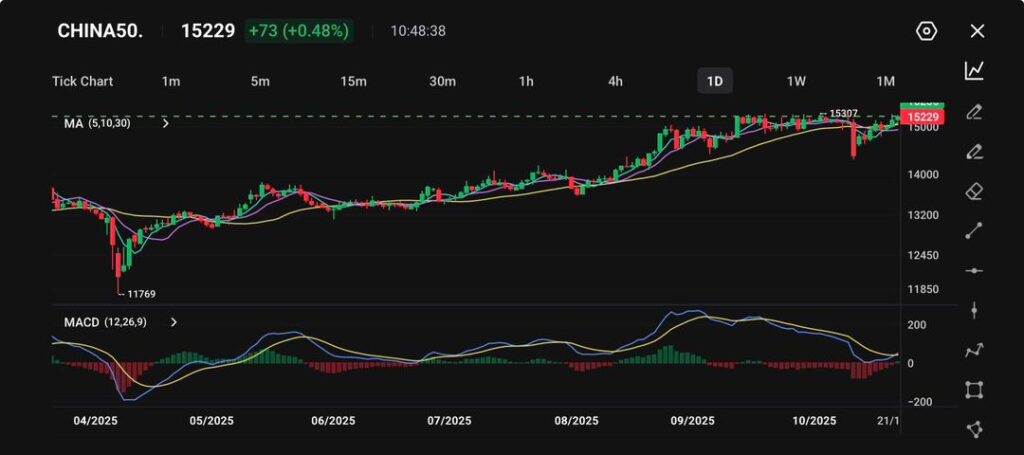
China’s financial markets entered the third quarter of 2025 under renewed pressure as U.S.–China trade tensions flared once again, amplifying volatility across asset classes.
The China A50 Index (CHINA50), which tracks the 50 largest mainland-listed companies, rallied sharply in early October to a multi-year high, reflecting renewed investor optimism before retreating modestly following new tariff threats from Washington.

Despite the pullback, the index remains up more than 18% year-to-date, driven by strong performances in technology and green energy sectors.
Daily turnover across Chinese equities continues to exceed CNY 2.2 trillion, suggesting that capital inflows and risk appetite remain resilient despite policy uncertainty.
In contrast, the bond market remains stable, with ten-year government yields anchored around 1.76% due to continued PBoC liquidity injections, lower default risks, and expanding issuance of green bonds.
In the foreign exchange market, the PBoC has maintained its benchmark lending rate unchanged for five consecutive months, striking a balance between growth support and financial stability.
The yuan has strengthened against the U.S. dollar, appreciating from April’s high of 7.35 to near 7.10 by mid-October. Meanwhile, China has continued to increase its gold reserves, adding five tonnes in Q3 as part of its broader strategy to hedge against geopolitical risks and global uncertainty.
Key Drivers
A combination of policy support, liquidity measures, and export diversification has shaped China’s market resilience. The PBoC injected CNY 530 billion in liquidity during Q3, bringing M2 money supply growth to 8.4% year-on-year and new loans to CNY 1.475 trillion. These measures have eased deflationary pressures and supported equity market recovery.
Institutional investors have also played a stabilising role, with insurance funds increasing A-share holdings by 30%, bolstering market confidence.
Government-backed economic transformation initiatives, notably in artificial intelligence and renewable energy, are expected to sustain medium-term market expansion.
On the macro front, Q3 GDP growth rose 1.1% quarter-on-quarter, beating expectations of 0.8%, and expanded 4.8% year-on-year. While slightly below Q1 and Q2 readings, it still outpaces the global average, underscoring China’s economic resilience.
Export data reveal a structural shift: shipments to the U.S. have fallen 27% this year, but exports to the EU, Southeast Asia, and Africa have grown 14%, 15.6%, and 56.4%, respectively.
Overall, exports contributed roughly 1.2 percentage points to GDP in the first three quarters.
Industrial production and retail sales continue to provide support, suggesting that while domestic consumption remains weak, exports and policy stimulus remain the primary growth engines. Full-year GDP growth is projected to reach around 5%.
Risks and Opportunities
Since President Trump reignited tariff tensions earlier this year, U.S.–China negotiations have oscillated between escalation and détente. Each round of reconciliation headlines tends to lift markets, while tariff threats trigger short-term corrections.
In early Q4, Beijing announced an expansion of rare earth export controls starting in December, a move that rattled global markets, given China’s dominance in rare earth supply chains critical to defence, electronics, and electric vehicles. Washington responded with a 100% import tariff on Chinese goods effective 1 November, prompting a 2% drop in the Shanghai Composite and 3–5% decline in the U.S. tech stocks.
The VIX index spiked 15%, while gold prices surged over $150 per ounce in a week.

However, markets generally expect eventual de-escalation, with traders eyeing upcoming bilateral talks for potential breakthroughs that could help reverse recent equity losses.
Beyond trade friction, China’s property sector remains a structural concern. Following a series of developer defaults — notably Evergrande — national housing inventory has climbed to record highs of 762 million square metres, up 15% year-on-year.
Inventory pressure is particularly acute in third- and fourth-tier cities, where the average destocking cycle has extended to 36 months.
Commercial properties face similar strain, with office vacancy rates at 18% in Shanghai, 15% in Beijing, and 25% in tier-two cities. Real estate debt accounts for roughly 30% of bank lending, posing systemic risks.
Authorities are countering this through rental conversion programmes (turning unsold units into affordable housing) and state-owned enterprise acquisitions of stalled projects. If successful, these policies could shorten the destocking cycle to 24 months by 2026, supporting financial stability and gradual recovery.
Outlook
China’s financial markets in 2025 embody a dual narrative of resilience and challenge. Equities remain in a structural bull trend, supported by policy easing and export strength, while the bond market stays steady and the yuan continues its mild recovery.
In the near term, investors should watch for outcomes of the upcoming U.S.–China summit, which could act as a catalyst for another market rally if talks conclude positively. Over the longer horizon, China’s growth trajectory will hinge on policy execution, industrial innovation, and effective management of the property overhang.
While trade war headlines and deflation risks remain key downside threats, continued policy coordination and technological advancement suggest that China’s markets could achieve more stable and sustainable growth heading into 2026.









